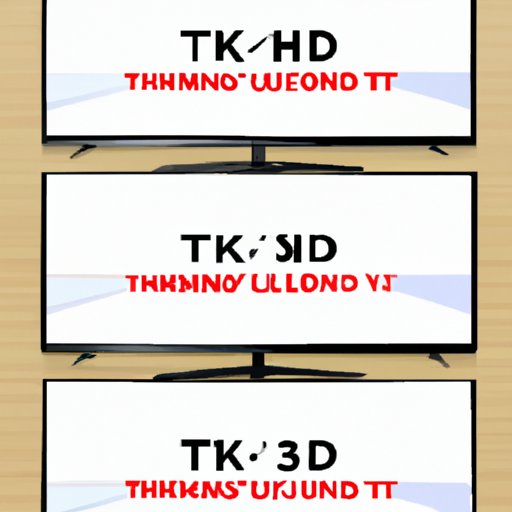Introduction
Television screens come in all shapes and sizes, but it’s important to know exactly how big your TV is before you buy one. Knowing the measurements of your TV screen can help you make an informed decision when it comes to finding the best fit for your home. This article will explore the different measurements of TV screens, how to measure them, and what the standard size is for a television set.

Exploring the Different Measurements of TV Screens
When it comes to measuring TV screens, there are several different measurements to consider. It is important to understand these measurements so that you can find the right size for your home. The three main measurements used to measure TV screens are diagonal, aspect ratio, and viewable area.
Diagonal Measurement
The most common way to measure a TV screen is by its “diagonal” measurement. This is simply the length of the diagonal line from one corner of the TV screen to the opposite corner. This measurement gives you an idea of how large the TV is, as well as how much space it will take up in your room. The diagonal measurement of a TV screen is usually given in inches.
Aspect Ratio
The aspect ratio of a TV screen is another important measurement to consider. This is the ratio between the width and height of the TV screen. Common aspect ratios are 4:3 (standard), 16:9 (widescreen), and 21:9 (ultra-wide). When buying a new TV, it is important to consider the aspect ratio of the TV to ensure that it will fit properly in your room.
Viewable Area
The viewable area of a TV screen is the actual amount of visible screen space. This is the area that you can actually see when looking at the TV, and it is usually slightly smaller than the diagonal measurement. To get an accurate viewable area measurement, you should measure the exact width and height of the TV screen.
What Is the Standard Size for a Television Screen?
When choosing a standard size for your TV, there are a few factors to consider. The size of the room where the TV will be placed is an important factor, as a larger room can accommodate a bigger TV. You should also consider the viewing distance, as this will determine how large the TV needs to be for optimal viewing. Finally, you should consider your budget, as larger TVs can be more expensive.

How to Measure Your TV Screen
Measuring a TV screen is fairly easy and only requires a tape measure or ruler. To measure the diagonal distance of the screen, simply measure from one corner of the screen to the opposite corner. For the viewable area, measure the exact width and height of the screen.
Understanding TV Screen Resolutions
In addition to the physical size of the TV screen, it is important to consider the resolution of the TV. The resolution of a TV is the number of pixels that make up the image on the screen. Higher resolutions will provide sharper images, while lower resolutions may result in a grainy or blurry picture. The most common resolutions are 1080p (Full HD) and 4K (Ultra HD).
Comparing Different Types of TV Screens
When shopping for a new TV, it is important to consider the type of screen you want. There are several different types of screens available, such as LCD, LED, OLED, and QLED. Each type of screen has its own advantages and disadvantages, so it is important to do some research to find the best one for your needs.
Conclusion
When shopping for a new TV, it is important to consider the measurements of the TV screen. The three main measurements are diagonal, aspect ratio, and viewable area. The standard size of a TV depends on the size of the room, the viewing distance, and your budget. In addition to the physical size of the TV, it is important to consider the resolution and type of screen. LCD, LED, OLED, and QLED are all popular types of screens, each with their own advantages and disadvantages. By understanding the different measurements and types of TV screens, you can make an informed decision when it comes to finding the perfect TV for your home.


